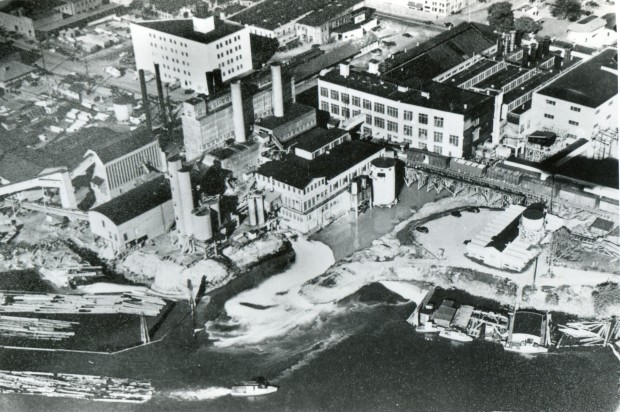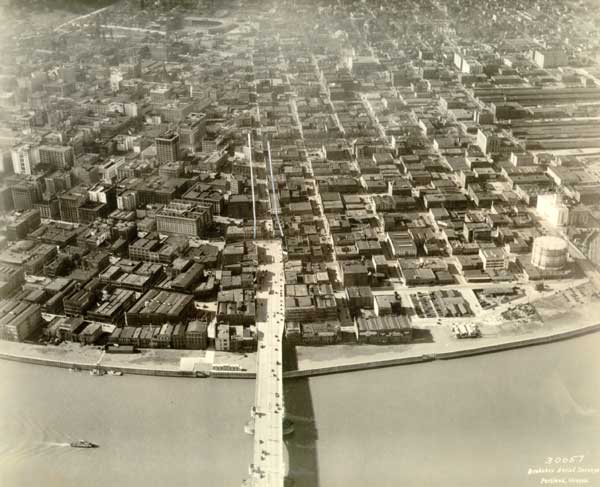Posts Tagged 2010s
Field trip to the former Boise Cascade Mill in Salem, OR
Posted by jvhillegas-elting in Beyond the Dusty Archives, Industries, Pulp & Paper Industry, Salem on December 16, 2017
To investigate and understand better historical landscapes, in September 2017 I took a field trip to Salem, Oregon, to discover what visible evidence might remain of the pulp and paper mill that used to exist in downtown Salem.

Aerial view (from the southwest) of the Oregon Pulp and Paper (later Boise Cascade) mill in Salem, 1949. Pringle Creek runs under the mill and railroad bridge at center, carrying untreated effluents into Willamette Slough, and then left (north) into the Willamette River. By the early 1970s, effluents were retained in ponds on Minto Island, west of the mill just beyond the frame at the bottom of the image. Willamette Heritage Center, P 2012.049.0115.
The mill began operations in 1920 as the Oregon Pulp and Paper Company, under the holding company Columbia River Paper Company. In 1962 the Boise Cascade Corporation took over. The mill ceased operations in 2007. In 2015, the South Block Apartments opened on the former mill site.
Read the rest of the entry to see my photos and learn a bit more . . .
“A City’s Lifeblood”
Posted by jvhillegas-elting in Columbia Slough, Other Websites & Sources, People, Institutions, and Groups, Portland Metro Area on December 10, 2017
Julia Rosen wrote an interesting article for the Oregon Humanities website on the topic of Willamette River cleanup titled “A City’s Lifeblood” (Aug. 22, 2017). She focuses on an important topic to investigate and document: racial/ethnic issues related to Willamette River and Columbia Slough pollution, including current clean-up and environmental enhancement plans. She had spoken with me a few months prior to publication to learn about the early days of pollution and pollution abatement.
As readers of my book will find, I don’t have much to say regarding the involvement of Native Americans, African Americans, or other non-white individuals or communities in cleanup efforts from the 1920s into the 1970s. This is because my research didn’t uncover anything explicitly on this topic. There are a few reasons why . . .
Portland harbor wall, then-and-now
Posted by jvhillegas-elting in Portland Metro Area, Sewers & Sewage on March 24, 2015

A few days ago, the Oregonian ran a “then-and-now” article on Portland’s harbor wall. In it, author John Killen referenced one of my posts, “Construction of Portland Harbor wall, 1927-1929.”
Industry threats in the face of environmental regulation: Crying wolf, or worth heeding?
Posted by jvhillegas-elting in Administration, Industries, Policy & Politics, Portland Metro Area on June 23, 2013
[Originally published on my blog Historical Threads on March 26, 2010. This version has been refined & corrected, where necessary. There are three comments at the original post.]
A few preliminary thoughts on the most recent discussion related to the Portland River Plan (sources cited below):
T. Alan Sprott wrote an OpEd on March 26. He’s the vice president of Vigor Industrial LLC in Portland and chair of the Working Waterfront Coalition. Reflecting on a lack of consensus with the Portland River Plan, he argues that Read the rest of this entry »
Recent news about the North Reach, Portland Harbor (March-May 2010)
Posted by jvhillegas-elting in Administration, Policy & Politics, Portland Metro Area on June 23, 2013
[Originally published on my blog Historical Threads on June 7, 2010. This version has been refined & corrected, where necessary.]
Below are a string of articles from March-May 2010 on the North Reach plan (documented for my own future reference):
Native salmon threatened with extinction from a cleaner Willamette River
Posted by jvhillegas-elting in Willamette River watershed on April 30, 2012
[Originally published on my blog Historical Threads on Sep. 8, 2011. This version has been refined & corrected, where necessary.]
 |
| Detroit Dam, Marion County, Oregon, July 1990. Photo Bob Heims, U.S. Army Corps of Engineers. |
Scott Learn has a very interesting article in today’s Oregonian about the negative impacts that Willamette River tributary dams are having on native salmon runs (“Getting salmon past daunting Willamette Basin dams could have a big price tag — and a big payoff“). This is a clear example of unintended consequences resulting from large-scale infrastructure projects.
When the Willamette Valley Project was first being proposed and planned in the 1930s and 1940s, advocates asserted that the dams would bring a great many benefits. Impounding tributary waters would help modulate the seasonal flow of the Willamette River which would, in turn, decrease the likelihood of downstream floods. The dams would also facilitate reclamation, irrigation, hydroelectric power production, and navigation improvements.[1] By storing water during the rainy months and metering its release during the dry months, Willamette Valley Project dams would modulate significant seasonal variations in the flow of the main stem, which would greatly help flush the river of industrial wastes and municipal sewage.[2]
Historian William G. Robbins has found that by at least the late 1930s there was significant opposition to Willamette Valley Project dams (and also dams along the Columbia, Rogue, Umpqua, and Deschutes rivers) based upon the projected negative impacts these dams would have on anadromous fish runs. These opponents included commercial and sports fishing groups, Columbia River treaty tribes, and wildlife conservationists in groups such as the Izaak Walton League, including renowned naturalist William L. Finley. Robbins quotes U.S. Fish and Wildlife Service biologist Paul Needham’s reference to these dams as “large-scale experiments” that did not sufficiently take the needs of fish into account.[3] It certainly cannot be said that Willamette Valley Project planners were entirely unaware of the likelihood of harm to salmon runs.
As Scott Learn writes in his article, in terms of healthy native anadromous fish runs, the Willamette Valley Project has certainly been a failed experiment. In terms of pollution abatement and flood control, however, the experiment has been quite successful. Therein lies the conundrum: How might we achieve the goals of healthy fish runs, a cleaner river, and a low incidence of catastrophic floods? Whatever the specific answers turn out to be, my hunch is that it will take both a fundamental shift in cultural values & priorities and a significant financial investment to achieve such mutually beneficial ends.
—-
[1] William G. Robbins, “The Willamette Valley Project of Oregon: A Study in the Political Economy of Water Resource Development,” Pacific Historical Review 47:4 (Nov. 1978), 585-605; William G. Robbins, Landscapes of Conflict: The Oregon Story, 1940-2000 (Seattle: University of Washington Press, 2004), 47-76.
[2] For more on Willamette River pollution generally, see James V. Hillegas, “Working for the ‘Working River’: Willamette River Pollution, 1926-1962,” MA thesis, Portland State University, 2009.
[3] Robbins, Landscapes of Conflict, 48-53.
—
Sixty years later, a prediction comes true . . . sort of.
Posted by jvhillegas-elting in Industries, Pulp & Paper Industry, Willamette River watershed on April 30, 2012
[Originally published on my blog Historical Threads on Sep. 27, 2011. This version has been refined & corrected, where necessary.]
This is fascinating: Metro is considering bidding for the recently-closed Blue Heron paper mill site in Oregon City at the base of Willamette Falls.[1] It would be great to have public access to this part of the river.
On another note, it appears that mill officials might have been correct when they predicted in 1949 that more stringent Willamette River water quality standards would run them out of business. However, does it count that the prediction was sixty years in coming to fruition, or that more stringent water quality standards do not entirely explain the demise of the mill?

